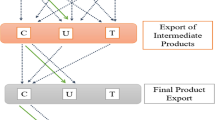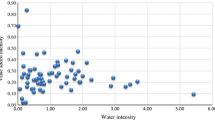Abstract
This article explores the cause-and-effect relationship between the exports of manufactured goods and water resources (virtual water). Little is known about virtual water flows in relation to Japan’s exports of manufactured goods. The research is based on the Japanese input-output tables and factor decomposition analysis (1980–2000). Virtual water exports include both “direct” water exports (the water utilized to manufacture final goods) and “indirect” water exports (the water required to produce intermediate goods). In the analysis, the change in virtual water exports is decomposed into three determinant factors: the direct water coefficient change, indirect water coefficient change, and export volume change. The findings imply that the export volume change was the most influential factor in determining the total volume of Japanese virtual water exports in the early 1980s; however, the volume of indirect water change exerts a stronger influence on the massive virtual water exports now and is greatly affected by subsidiaries. Manufacturers depend on the supply of water from developing countries to enhance their competitive strengths. Thus, the article suggests possible changes in virtual water trade flows between Japan and other countries.
Similar content being viewed by others
References
Anon. (2001) Annual reports on Japanese economy and public finance/economic survey of Japan. Chap. 1 Sect. 2.3 (1986), Chap. 1 Sect. 6 (1990), Chap. 4 Sect. 2 (1991), Cabinet Office, Tokyo. http://wp.cao.go.jp/zenbun/keizai/index.html and http://www5.cao.go.jp/keizai/index-e.html. Cited on 4 June, 2005
Baumann DD, Boland JJ, Hanemann WM (1998) Urban water demand management and planning. McGraw-Hill, New York, pp 27–29
Beppu S (2003) Accelerating water Business. Water Crisis in the 21st Century. Noubunkyo, Tokyo, pp 57–66
Biswas AK (1997) Water resources: environmental planning, management, and development. McGraw-Hill, New York, pp 3–6
Easter KW, Rosegrant MW, Dinar A (1998) Markets for water: potential and performance. Kluwer, Norwell, Massachusetts, pp 35–38
IBM (2002) Environment well-being progress report: water resources. http://www-6.ibm.com/jp/company/environment/2002/shigen.html. Cited on 28 May, 2005
Japan Association for Construction-Industry (2004) Water jet technology. http://www.diana.dti.ne.jp/∼jacon/index-j.html. Cited on 28 May, 2005
Japan Patent Office (2000) Patent statistics (2000): patent map—cutting method. Japan Patent Office, Tokyo, p 337. http://www.jpo.go.jp/shiryou/s_sonota/map/kikai22/s/s-3.htm. Cited on 9 June, 2005
Kanada N (2001) Land resources and international trade (in Japanese). Taga Shuppan, Tokyo, pp 45–49
Li ZD (1998) Environmental problems in China and its environmental protection systems. In: Society for Environmental Economics and Policy Studies: environmental problems in Asia. Toyo Keizai Shinpou Sha, Tokyo, pp 213–227
Merrett S (1997) Introduction to the economics of water resources: an international perspective. Rowman and Littlefield, Lanham, Maryland, pp 53, 63–66
Ministry of Economy, Trade, and Industry (2000) The Japanese census of manufactures (1980), (1985), (1990), (1995), and (2000): report of industrial land and water. Research and Statistics Department, Economic and Industrial Policy Bureau, Ministry of Economy, Trade, and Industry, Tokyo
Ministry of Economy, Trade, and Industry (2004) Results of the basic survey of Japanese business structure and activities. (2004) p 6 (summary), p 37 (Chap. 3), p 48 (Chap. 4); (2003) p 93 (Chap. 4); (2002) p 60 (Chap. 3); (2001) p 47 (Chap. 3); (2000) p 34 (Chap. 3); (1999) p 34 (Chap. 3); (1992, 1995–1998). Research and Statistics Department, Economic and Industrial Policy Bureau, Ministry of Economy, Trade and Industry, Tokyo. http://www.meti.go.jp/statistics. Cited on 9 June, 2005
Ministry of International Trade and Industry (2000) The Japanese input-output tables (1980), (1985), (1990), (1995), and (2000). Research and Statistics Department, Minister’s Secretariat, Ministry of International Trade and Industry, Tokyo
Ministry of Land, Infrastructure, and Transport (2004) Water resources in Japan. Ministry of Land, Infrastructure, and Transport, Tokyo, p 69
Miyake M, Oki T, Musiake K (2002) Basic study of virtual water trade of Japan (in Japanese). 6th Symposium on Water Resources, Committee for the Symposium for Water Resources, pp 728–733
OMRON (2004) Sustainability report—water consumption among foreign manufacturing subsidiaries. http://www.omron.co.jp/corporate/kokisei/siterep/kaigai.html. Cited on 9 June, 2005
Spulber N, Sabbaghi A (1998) Economics of water resources: from regulation to privatization, 2nd edn. Kluwer, Norwell, Massachusetts, pp 15–18
Wackernagel M, Rees W (1996) Our ecological footprint: reducing human impact on the earth. The New Catalyst Bioregional Series 9. New Society, British Columbia, Canada, pp 3–9
Winpenny J (1994) Managing water as an economic resource. Routledge, New York, pp 27–28
Yamaoka K, Ochii Y (2003) A message from Japan and Asia to the world water discussions. The Japanese Institute of Irrigation and Drainage (JIID), Tokyo, pp 2–6
Yomiuri Newspaper (2004) Industrial water cost in Osaka (in Japanese). 14 October 2004
Author information
Authors and Affiliations
About this article
Cite this article
Kondo, K. Economic analysis of water resources in Japan: using factor decomposition analysis based on input-output tables. Environ Econ Policy Stud 7, 109–129 (2005). https://doi.org/10.1007/BF03353947
Received:
Accepted:
Published:
Issue Date:
DOI: https://doi.org/10.1007/BF03353947




